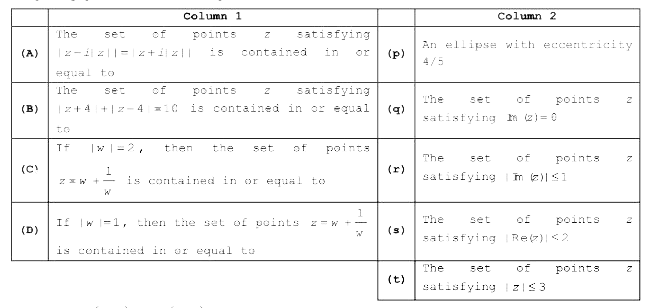Show that the equation of a circle passings through the origin and having intercepts a and b on real and imaginary axis, respectively, on the argand plane is Re(z−az−ib)=0Solution in Bengali
According to the question, we have circle as shown in the figure.

Clearly, complex numbers 'a' and 'ib' are and points of diameter. So, for any complex number z on the circle, we have
arg(z−az−ib)=±π2
Thus, z−az−ib is purely imaginary.
∴ Re(z−az−ib)=0
Topper's Solved these Questions
- BOOK - CENGAGE PUBLICATIONCHAPTER - COMPLEX NUMBERSEXERCISE - SLOVED EXAMPLES15videos
COMPLEX NUMBERS
- BOOK - CENGAGE PUBLICATIONCHAPTER - COMPLEX NUMBERSEXERCISE - EXERCISE3.14videos
COMPLEX NUMBERS
- BOOK - CENGAGE PUBLICATIONCHAPTER - COMPLEX NUMBERSEXERCISE - Comprehension11videos
COMPLEX NUMBERS
- BOOK - CENGAGE PUBLICATIONCHAPTER - CIRCLESEXERCISE - Comprehension Type8videos
CIRCLES
- BOOK - CENGAGE PUBLICATIONCHAPTER - CONIC SECTIONSEXERCISE - All Questions102videos
CONIC SECTIONS
Similar Questions
ifωandω2 are the nonreal cube roots of unity and [1/(a+ω)]+[1/(b+ω)]+[1/(c+ω)]=2ω2 and [1/(a+ω)2]+[1/(b+ω)2]+[1/(c+ω)2]=2ω , then find the value of [1/(a+1)]+[1/(b+1)]+[1/(c+1)].
05:02View SolutionIs the following computation correct? If not give the correct computation: [√(−2).√(−3)]=√(−2).−3=√6
06:28View SolutionConsider the region R in the Argand plane described by the complex number. Z satisfying the inequalities |Z−2|≤|Z−4|, |Z−3|≤|Z+3|, |Z−i|≤|Z−3i|, |Z+i|≤|Z+3i|
Answer the followin questions :
Maximum of |Z1−Z2| given that Z1, Z2 are any two complex numbers lying in the region R is02:19View Solution
In the diagram as shown, a circle is drawn with centre C(1,1) and radius 1 and a line L. The line L is tangent to the circle at Q. Further L meets the y-axis at R and the x-axis at P in such a way that the angle OPQ equals θ where 0<θ<π2.
Coordinate of Q is01:59View SolutionGiven that A(1,1) and B(2,−3) are two points and D is a point on AB produced such that AD=3AB. Find the coordinates of D.
02:47View SolutionIf z≠1 and z2z−1 is real, then the point represented by the complex number z lies (1) either on the real axis or on a circle passing through the origin (2) on a circle with centre at the origin (3) either on the real axis or on a circle not passing through the origin (4) on the imaginary axis
05:46View SolutionShow that the equation of a circle passing through the origin and having intercepts aandb on real and imaginary axes, respectively, on the argand plane is given by z¯z=aa(Rez)+b(Imz).
04:03View SolutionIntercept made by the circle zbar(z)+bar(a)+abar(z)+r=0 on the real axis on complex plane is
01:52View SolutionEquation of the circle passing through the origin and makes intercepts 4 and 6 on negative x -axis & negative y -axis respectively is
View SolutionShow that the equation of a circle passings through the origin and having intercepts a and b on real and imaginary axis, respectively, on the argand plane is Re(z−az−ib)=0
01:59View SolutionFind the equation of the plane passing through the lineof intersection of the planes x+2y+3z−5=0 and 3x−2y−z+1=0 and cutting off equal intercepts on the x-axis and z-axis.
02:59View SolutionThe equation of a plane passing through the line of intersection of the planes :
x+2y+z−10=0and3x+y−z=5 and passing through the origin is :02:49View SolutionEquation of plane passing through (2,1,3) making equal intercepts on X-axes and Y-axes, and having Z-intercept 4, is
03:05View SolutionHere, z takes values in the complex plane and Im(z) and Re(z) denote respectively, the imaginary part and the real part of z.
 07:27View Solution
07:27View SolutionThe equation of the plane with intercepts, 2,5 and 4 on the x,y and z axis respectively is .............
04:36View SolutionShow that the equation of a circle passing through the origin and having intercepts a and b on real and imaginary axes, respectively, on the argand plane is given by z¯z=a(Rez)+b(Imz).
01:59View Solution

